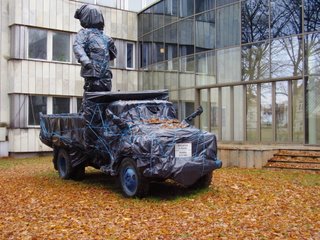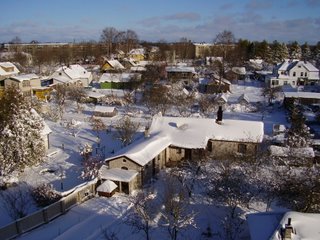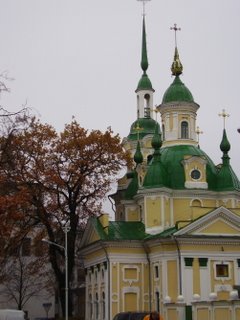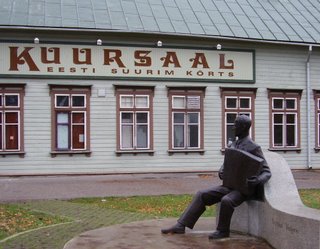 There's lots to see in Tartu, officially, the City of Good Thoughts, including the KGB Cells Museum, where there must have been many good thoughts. Estonia's Second City is arguably built around the University of Tartu, which will celebrate its
There's lots to see in Tartu, officially, the City of Good Thoughts, including the KGB Cells Museum, where there must have been many good thoughts. Estonia's Second City is arguably built around the University of Tartu, which will celebrate its  375th anniversary in 2007.
375th anniversary in 2007.
I hadn't been to Tartu since 1999 or 2000, when I was still in the Peace Corps. So over the Christmas break, I met up with a Returned Peace Corps Volunteer still living in Tartu for an insider's tour of what has become, I believe, a fairly Westernized yet incredibly walkable city of 100,000 residents.
Here is the main building of the University of Tartu; city hall, constructed in the late 1780s, and, in front of it, the city square; and the steeple of St. John's Church, founded around the 14th century.
29 December 2006
Tartu: The Second City of Estonia
26 December 2006
Apostlite Peetruse ja Pauluse Kogudus
 At last, inside the Cathedral of the Apostles Peter and Paul, the only Catholic church in Tallinn, it felt like Christmas. From the plywood manger scene outside to the lingering incense clouds inside, here was the joyful Christmas that I had not yet really seen, smelled, or felt.
At last, inside the Cathedral of the Apostles Peter and Paul, the only Catholic church in Tallinn, it felt like Christmas. From the plywood manger scene outside to the lingering incense clouds inside, here was the joyful Christmas that I had not yet really seen, smelled, or felt. Bishop Philippe Jourdan, a Frenchman, said Mass in Estonian (his sermon was little long for any language), and we sang the "Gloria," the "Holy, Holy, Holy," and the "Lamb of God" in Latin. The male cantor was excellent, and the accompanying, mostly male choir it sounded like, had a bit of a funky African folk rhythm in them. A woman sang a beautiful song at communion, and I wished that, throughout Estonia, they'd move the damn choirlofts to the front of the church so we could see who was singing. No one applauded at the end of Mass, though. In fact, many people knelt back down to pray.
Bishop Philippe Jourdan, a Frenchman, said Mass in Estonian (his sermon was little long for any language), and we sang the "Gloria," the "Holy, Holy, Holy," and the "Lamb of God" in Latin. The male cantor was excellent, and the accompanying, mostly male choir it sounded like, had a bit of a funky African folk rhythm in them. A woman sang a beautiful song at communion, and I wished that, throughout Estonia, they'd move the damn choirlofts to the front of the church so we could see who was singing. No one applauded at the end of Mass, though. In fact, many people knelt back down to pray. Christmas Day 2006


In Tallinn, my camera and I had a little more than an hour in the Old City to record hints of Christmas. Electric candelabrums appear in windows everywhere here on the first Sunday of Advent. They have either five, seven, or nine candles and, very simply, both phsically and metaphorically, they bring light to a time of darkness. While I doubt the candelabrums with seven candles celebrate the seven principles of Kwanzaa, I think all of the candelabrums may be connected to St. Lucia Day, which Scandanavian girls celebrate by wearing candles on their head. Go figure.

The Russian Orthodox Church celebrates Christmas on January 7, two weeks after the Western World. They use the old Julian calendar instead of the 16th century Gregorian calendar. So, in Tapa, the Christmas program at the Russian high school, which I attended, was actually a New Year's celebration.
A variation of the candelabrums in the windows is the citronella-like candles (I mean, they are big like citronella candles but don't smell like them!) in front of shops, bars, and restaurants - really, in front of anywhere you are welcomed to come into. Notice that the sign says "Open", which is not Estonian, Russian, or Finnish.
 The House of the Brotherhood of the Blackheads dates back to the 16th century, before there was acne as we know it today. Actually, St. Mauritius, a black Egyptian, was the guild's patron. His black head is the guild's mascot and on its coat of arms. The state banquet Estonian President T.H. Ilves threw for Queen Elizabeth II and the Duke of Edinburgh was held here in October.
The House of the Brotherhood of the Blackheads dates back to the 16th century, before there was acne as we know it today. Actually, St. Mauritius, a black Egyptian, was the guild's patron. His black head is the guild's mascot and on its coat of arms. The state banquet Estonian President T.H. Ilves threw for Queen Elizabeth II and the Duke of Edinburgh was held here in October.That's A.H. Tammsaare, who wrote the great Estonian novel Truth and Justice, checking out the Christmas tree in the park named in his honor.
Finally, steadily, as the day progressed, from 10 a.m. when I got off the train to 2:00 when I headed back to the Balti Jaam, more and more people strolled around the Christmas Market.
'Twas the Night before Christmas
 service in EELK Tapa Jakobi kogudus, the local Lutheran church. The Estonian language is a little interesting here. Kirik is church; kogudus is congregation, or could be parish. So when, in English, we say St. Jacob's Estonian Evangelical Lutheran Church (kirik), Estonians say St. Jacob congregation, or parish, (kogudus). Church (kirik) refers only to the building; Congregation, or parish, refers to the community of parishioners.
service in EELK Tapa Jakobi kogudus, the local Lutheran church. The Estonian language is a little interesting here. Kirik is church; kogudus is congregation, or could be parish. So when, in English, we say St. Jacob's Estonian Evangelical Lutheran Church (kirik), Estonians say St. Jacob congregation, or parish, (kogudus). Church (kirik) refers only to the building; Congregation, or parish, refers to the community of parishioners. I snuck out of the service for an unplanned, unscheduled shopping trip to Tallinn, where, already, there are just as many political advertisements for the March 2007 elections as there are Christmas decorations. I'm proud to say that the Christmas lights along the length of my building make it one of the most festive in Tapa!
I snuck out of the service for an unplanned, unscheduled shopping trip to Tallinn, where, already, there are just as many political advertisements for the March 2007 elections as there are Christmas decorations. I'm proud to say that the Christmas lights along the length of my building make it one of the most festive in Tapa!Estonians celebrate Christmas on Christmas Eve, because I don't think there is any Estonian child who would get up at 5 o'clock in the morning to see what Santa had left for them. There's not an Estonian child who would get up at 5 o'clock period. The kids here like their sleep. I spent Christmas Eve with the same family that I went potato-picking with in the fall. While cold beer, close friends, and a wood-burning sauna always bring a smile to my face, they are no match for the joy of watching a child opening a Christmas present.
16 December 2006
A Very Special Visitor
Estonian Pumpkin Pie from Scratch
All Shapes and Sizes
02 December 2006
Thanksgiving 2006 (Koolis)

In December 1620, English pilgrims arrived in Plymouth and had very little food. In the spring of 1621, Wampanoag Indians showed the pilgrims what crops to plant in order to survive the upcoming winter. That fall, the pilgrims and the Indians celebrated an abundant harvest.
03 November 2006
The USSR and the CCCP
I think in grade school I knew what the USSR was. It was right up there with the Devil himself. Then in high school I think I learned that the letters stood for the Union of Soviet Socialist Republics, but I never really comprehended (was it just me or my history and geography books)that there were indeed individual republics like Estonia, Latvia, and Lithuania. Moscow alone was reportedly quite a formidible enemy.
In all honesty, I really never knew why, when watching the Olympic games on telelvision, the athletes from the USSR had CCCP on their uniforms. Assuming that CCCP were Roman letters, too, I always wondered what were they calling their country during international competition?
Well, at long last, I have learned that CCCP are letters in the Cyrillic alphabet, too, and they pretty much stand for: Союз Советский Социалистический республиканский, which is Russian for the Union of Soviet Socialist Republics. By the way, R is P in the Russian language, but still sounds like an R (I think).
Artsy Fartsy Estonians


 While Estonian food is generally bland, Estonian artists are surprisingly savory - piquant, acerbic, spicy, and even nouveau.
While Estonian food is generally bland, Estonian artists are surprisingly savory - piquant, acerbic, spicy, and even nouveau.
Here are (counter-clockwise) an outside wall of the L-shaped library (raamatukogu) in Pärnu, a peppery piece of art called "Forbidden History" outside the Pärnu Museum of New Art (which would easily be at home in the MCA in Chicago), and your everyday anarchy graffiti on a historically significant wall, which says something to the effect that through uprisings and revolutions, we raise up others' heads to our cause.
Snow for Halloween: The Ultimate Trick or Treat





Take a deep breath. Take a look at September 18 in the archives. Sigh. Come back here. Take a deep breath again. Now, you're ready for Estonia's winter.
Not!
More than six inches has fallen over the last four days. What was rain and rain and more rain in Pärnu was snow and snow and more snow two hours inland in Tapa.
02 November 2006
Pärnu

 Pärnu, on the western coast of Estonia, is the country's summertime capital. Yet it's beauty is just as evident in the late fall, when I was there.
Pärnu, on the western coast of Estonia, is the country's summertime capital. Yet it's beauty is just as evident in the late fall, when I was there.
Below, there's Raimond Valgre with his accordion outside what is said to be Estonia's largest beer hall.
I heard the Tallinn Boys' Choir sing Purcell's "Funeral Music of Queen Mary" inside St. Elizabeth's Church, built in 1747 for Elizabeth, Empress of Russia. St. Catherine's Church, with the green roof, was built in 1768 for Empress Catherine II. The brown, brick Lord's Transfiguration Orthodox Church was built in 1904.






























